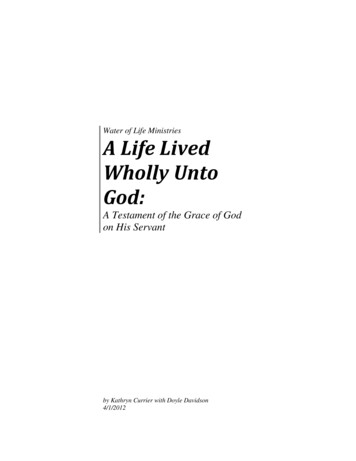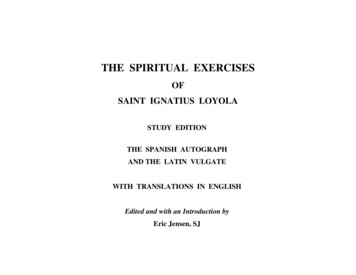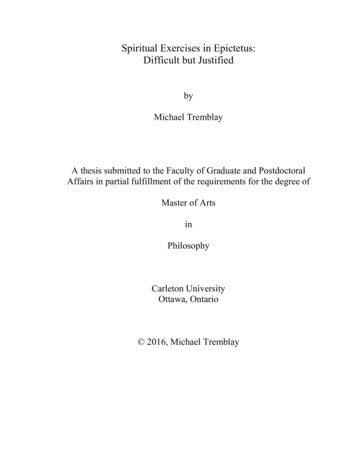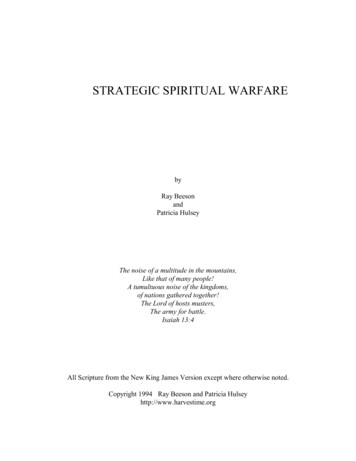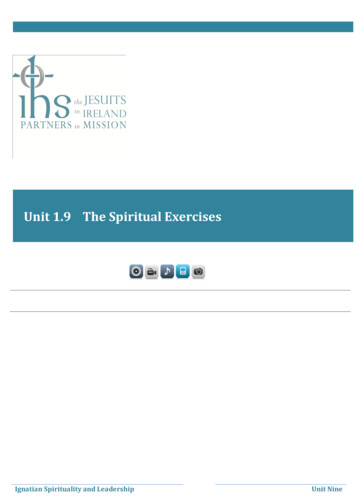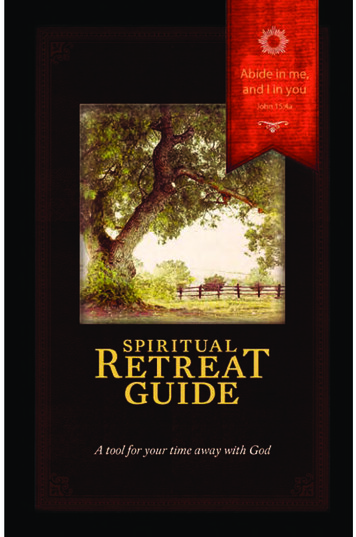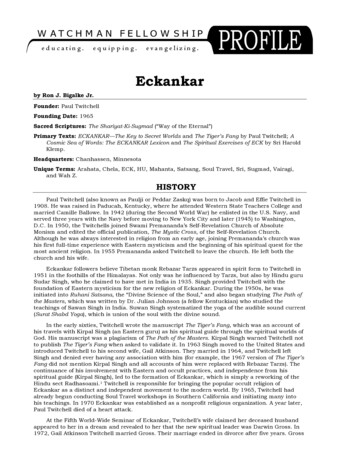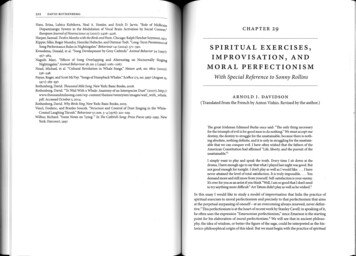
Transcription
522DAVID ROTHENBERGHara, Erina, Lubica Kubikova, Neal A. Hessler, and Erich D. Jarvis. "Role of MidbrainDopaminergic System in the Modulation of Vocal Brain Activation by Social Contexf'European Journal ofNeuroscience 25 (2007): 3406-3416.Harper, Samuel. Twelve Months with the Birds and Poets. Chicago: Ralph Fletcher Seymour, 1917.Kipper, Silke, Roger Mundry, Henrike Hultsche, and Dietmar Todt. "Long-Term Persistence ofSong Performance Rules in Nightingales:' Behaviour 141 (2004): 371-390.Kroodsma, Donald, et al. "Song Development by Grey Catbirds:' Animal Behavior 54 (199?):457-464.Naguib, Marc. "Effects of Song Overlapping and Alternati:cy.g on Nocturnally SingingNightingales:' Animal Behaviour 58, no. 5 (1999 ): 1061-1067.Noad, Michael, et al. "Cultural Revolution in Whale Songs:' Nature 408, no. 6812 (2ooo):536-548.Payne, Roger, and Scott McVay. "Songs ofHumpback Whales:' Sciè'hce 173, no. 3997 (August 13,1971): sss-597·Rothenberg, David. Thousand Mile Song. New York: Basic Books, 2008.Rothenberg, David. "To Wail With a Whale: Anatomy of an Interspecies Duet" (2007), http://www. thousandmilesong.com/ wp- content/ them es/ twentyten/ images/wail wi th whale.pdf. Accessed October 5, 2014.Rothenberg, David. Why Birds Sing. New York: Basic Books, 2005.Vencl, Frederic, and Branko Soucek. "Structure and Control of Duet Singing in the WhiteCrested LaughingThrush:' Behaviour 57, nos. 3-4 (1976): 221-229.Wilbur, Richard. "Sorne Notes on 'Lying:" In The Catbird's Song: Prose Pieces 1963-1995. NewYork: Harcourt, 1997-CHAPTER 29SPIRITUAL EXERCISES,IMPROVISATION, ANDMORAL PERFECTIONISMWith Special Reference to Sonny RollinsARNOLDI.DAVIDSON(Translate cl from the French by Anton Vishio. Revised by the author.)The great Irishman Edmund Burke once said: "The only thing necessaryfor the triumph of evil is for good men to do nothing:' We must accept ourdestiny, the destiny to struggle for the unattainable, because there is nothing absolute, nothing definite, and it is only in struggling for the unattainable that we can conquer evil. I have often wished that the fathers of theAmerican Constitution had affirmed "Life, liberty, and the pursuit of theunattainable:'1I simply want to play and speak the truth. Every time I sit down at thedrums, I have enough ego to say that what I played last night was good. Butnot good enough for tonight. I don't play as weil as I would like. . . I havenever attained the level of total satisfaction. It is truly impossible . Youdemand more and still more from yourself. Self-satisfaction is your enemy.It's over for you as an artist if you think "Weil, I am so good that I don't needto try anything more difficult:' Art Tatum didn't play as weil as he wished. 2IN this essay 1 would like to study a model of improvisation that links the practice ofspiritual exercises to moral perfectionism and precisely to that perfectionism that aimsat the perpetuai surpassing of oneself-at an overcoming always renewed, never definitive. 3 This perfectionism is at the heart of recent.work by Stanley Cavell: in speaking of it,he often uses the expression "Emersonian perfectionism;' since Emerson is the startingpoint for his elaboration of moral perfectionism. 4 We will see that in ancient philosophy, the idea of wisdom, or better the figure of the sage, could be interpreted as the historico-philosophical origin of this ideal. But we must begin with the practice of spiritual
524ARNOLDI.DAVIDSONexercises. Regarding the notion of a "spiritual exercise;' at the beginning of his bookWhat Is Ancient Philosophy?, Pierre Hadot writes:By this term, I mean practices which could be physical, as in dietary regimes, or discursive, as in dialogue and meditation, or intuitive, as in contemplation, but whichwere all intended to effect a modification and a transformation in the subject whopracticed them. The philosophy teachers' discourse could also assume the form of aspiritual exercise, if the discourse were presented in such a way that the disciple, asauditor, reader, or interlocutor, could make spiritual progre s and transform himselfwithin. 5In short, as Hadot said in our book of conversations, a spirittl,hll exercise is "a voluntary,personal practice intended to bring about a transformation of the individual, a transformation of the self;' and among the significant examples of such a practice he cites acertain practice of Beethoven, precisely because Beethoven "referred to the exercises ofmusical composition that he required of his students, and that were meant to allow themto attain a form of wisdom-one that might be called aesthetic-as spiritual exercises:' 6According to Hadot, in antiquity, philosophy is "that activity by means of whichphilosophers train themselves for wisdom"; here one must underline the expression"train for wisdom;' because wisdom itself is a "transcendent norm:'7 Thus, "philosophy, for mankind, consists of efforts toward wisdom which always remain unfinished:' 8Describing in detail the figure of the sage in ancient philosophy, and especially in theStoic school, Hadot writes:Foremost, for the Stoics, the sage is an exceptional being; there are very few, perhapsone, even none at all. The figure of the sage is thus for them an almost unattainableidea, more a transcendent norm than a concrete figure . The Stoic philosopherknows that he can never realize this ideal figure of the sage, but it exercises on him itsattraction, provokes in him enthusiasm and love, allows him to he ar a call to live better, to become aware of the perfection which he strives to attain . The philosopherwho trains for wisdom will try to form a nucleus of inexpugnable inner freedom viaspiritual exercises. 9Th us, it could be concluded, I believe, that philosophy as a spiritual exercise toward wisdom is a form of moral perfectionism and therefore a particular way oflife.Now, I can easily imagine your perplexity: spiritual exercises, moral perfectionism,wisdom, what does all of this have to do with the improvisations of the saxophonistSonny Rollins? From my point of view, philosophy is not primarily a doctrine or a theory, but rather an activity and an attitude. This is why nothing prohibits the attitude thatis expressed in certain acts of improvisation from being named, without hesitation orequivocation, "philosophical:'10 The activity of improvisation becomes a philosophicalactivity wh en one deploys a practice of spiritual exercises th at aims at perfecting oneself.From this perspective, Rollins is a perfect example of a model of moral perfectionismsustained by spiritual exercises.SPIRITUAL EXERCISES, IMPROVISATION, AND MORAL PERFECTIONISM525In a 2006 interview, Rollins said, 'Tm dissatisfied and l'rn always striving. A lot ofguys have learned their craft and they get to a place, and they are satisfied, and the stuffthey do is great. . In my case, my thing is constantly loo king for something else. l'rnnot satisfied yet. I know there is more there:'11Rollins's dissatisfaction is certainly an aesthetic disposition, but it is also and aboveallan ethical attitude: Rollins is always searching for his "next self" -something beyondhimself, a spiritual place never completely reached. In discussing his concerts, famousfor their extreme ardor and energy, Rollins a:ffirms:There are certain concerts that I play, performances when I do feel that I havereached the higher level. When that happens as a normality rather than rarely, thenI will feel that I am there. Then there will probably be something else I need to do,but I do feel that I am getting doser to more of a complete expression. It's a reachablegoal, it is not something which is never going to happen, but that doesn't mean thatwill be the end. There will always be something else to do. I think 1 can get to a betterplacePHere we can glimpse the possibility of a progress that is, so to speak, spiritual ("thehigher level;' "1 am getting doser to a more complete expression''), but, at the same time,the feeling that a definitive end is impossible ("then there will probably be somethingelse I need to do"). Moreover, Rollins makes use of an explicitly ethical vocabulary tocharacterize his attitude ("I think I can get to a better place").In another interview, from 2008, Rollins clearly articulates the paradox representedby the duty to attain an end that is indeed impossible to attain-a paradox typical ofmoral perfectionism: "What l'rn looking for perhaps is unattainable. 1 know that. ButI certainly have a right to try to achieve it. It's my duty to achieve it:'13This duty of reaching an inaccessible place is no metaphysical abstraction: it is rathera duty that is made concrete in the necessity of exercising oneself. In effect, this existential obligation, with its highly particular structure, is elaborated in various traditions ofthought and of practice. Cavell has often insisted on the fact that moral perfectionismis not another moral theory, but rather an attitude, a perspective, a vision of the worldthat traverses the history of thought and of life. To cite a single unexpected example ofthis perfectionist dimension: in a system of practices as remote as possible from those ofRollins, namely Orthodox Judaism, one finds, according to Yeshayahou Leibowitz, theidea of a "reality always beyond that which is, that one can never attain, but which, nevertheless, one must ceaselessly strive to attain:' What is such a reality called? Accordingto Jewish tradition, its name is precisely "redemption;' a redemption therefore that isalways still to come. 14 In my opinion, as we will see, in his own tradition Rollins himselfis a figure of this redemption, that is to say of this infinite exercise of ourselves.Rollins is renowned for the periods during which he did nothing other than practice,up to 15 hours per day. That which Rollins dubbed his "relentless practicing" is a way ofmanifesting his ethical attitude:
ARNOLDI.DAVIDSONSPIRITUAL EXERCISES, IMPROVISATION, AND MORAL PERFECTIONISM527I've taken severa! sabbaticals from performing and recording. I have a certain idealwhen I play, and this ideal has changed over the years. I've taken breaks because I'vebeen frustrated with a performance or I just wanted togo to the woodshed and experiment. I always become frustrated when l'rn not reaching what I hear for myself. Inever viewed practicing as a chore. I always saw it as a necessity to improve. 15The interminable exercises of Rollins also highlight the priority of a certain relationship with oneself and, in the case of Rollins, the necessity of forming oneself in such away that improvisation can become unlimited. This imprdvisation, infinite in a certainsense, presupposes, according to Rollins, a very particular relationship with oneselfstrong but at the same time mobile. lt is just such a relationship with oneself that occupies the center of Rollins's existential attitude: "This is the ruggle of life, to be betterpeople. That's how 1 figured out what life is all about. This is what 1 am trying to do. Lifeis an opportunity, but the hardest battle is with ourselves. That is what I realize, and that'swhat I am doing. What matters is you winning the battle with yourself' 16This attitude is the foundation, the core of Rollins's judgment: ''As far as I am concerned, a good band starts with yourself. It starts with me getting my stuff together:'17And "getting your stuff together" is a task that one is never finished with.Let us take the example of the relationship with oneself expressed by Rollins in themusic he created in the 1950s. In this music, one finds what I will call a "horizontalinexhaustibility" within a form of the self. Let me exp lain: Rollins created a form ofhimself that allowed him never to exhaust an improvisation, to always invent new possibilities, as if the improvisation was, literally, an infinite creation without determinate limits. The form of Rollins's self at the end of the 1950s is a form never filled in,one that precedes all substance, a form without weight, always in movement, vital, aform, one might say, who se dimensions are limitless. It is a form that responds preciselyto Rollins's incessant exercises. Consider "l'rn an Old Cowhand" from the recordingWay Out West (1957; see Figure 29.1). 18 Rollins's solo is magnificent; one perceives init, at the same time, both imagination and organization, yet it is a solo that is in a clearsense unfinished. However, its felt incompleteness is of a very particular kind; it concerns the inexhaustibility of the improvisation, an inexhaustibility achieved thanks toa certain practice, a certain form of the self. In listening to the alternate take of 'Tman Old Cowhand;' nearly twice as long as the first version, one understands immediately th at Rollins is capable of continuing ad infinitum, until the end of the world, without repeating himself. The fadeout of this alternative take is a sign of the interminableactivity of his improvisation, a symbol of his capacity to never fill in his own form ofthe self; rather, he is always ready to dilate himself and to prolong himself, to go forward. Without any doubt, in these years, there was a sound, a clear style, that is to say adistinctive form called Rollins, precisely that form which, within a piece, authorized abeyond, always elsewhere, further on, which knew no permanent pause, no definitiveconclusion, no resting in peace.Often it is Rollins's cadences that demonstrate in the most unforgettable manner thishorizontal inexhaustibility; these are very evident moments of his infinite creativity. TheFIGURE 29.1 SonnyRollins ((1957]2010).form that Rollins gives to these cadences expresses, moreover, a musical version of theco smic consciousness described by Hadot. Among the aspects of this co smic consciousness that Hadot emphasized, there is the exercise of dilation, of the expansion of the selfinto the cosmos, that is, the exercise "ofbecoming aware of his being within the All, as aminuscule point ofbrief duration, but capable of dilating into the immense field of infinite space and of seizing the wh ole of reality in a single intuition:' 19 At the same time thathe describes the ideal of stoic wisdom, Hadot speaks of cosmic consciousness, evoking aconnection between each instant and the entire universe:By becoming conscious of one single instant of our lives, one single beat of ourhearts, we can fe el ourselves linked to the, entire immensity of the cosmos, and tothe wondrous fact of the world's existence. The wh ole universe is present in eachpart of reality. For the Stoics, this experience of the instant corresponds to theirtheory of the mutual interpenetration of the parts of the universe. Such an experience, however, is not necessarily linked to any theory. For example, we find it
l528SPIRITUAL EXERCISES, IMPROVISATION, AND MORAL PERFECTIONISMARNOLDI.DAVIDSON529expressed in the following verses by Blake: To see a World in a Grain of Sand 1Anda Heaven in a Wild Flower, 1 Hold Infinity in the palm of your hand 1And Eternityin an hour. 20The intuitions, the pulsations of Sonny Rollins unveil the entire musical universe, infinity heard in the mouthpiece of a saxophone. Rollins's breathing is metamorphosizedinto a short melody of several notes that leads us on to a second melody, and then to yetanother, etc.-melodies between which we discover a recigrocal compenetration neverimagined. Or else a melody transforms itself into an extended improvisation that links,in a spontaneous and natural mann er, "high'' music with "popular" music, jazz and classical music, ali the different moments of the history of jazz, and so on. Ali things considered, it seems that a single note of Rollins encompasses, from the outset, ali musicalworlds, as if his improvisation unravels the cosmos itself. And one can understand thatthe consciousness of Rollins "is plunged, like Seneca, into the totality of the cosmos: tati1se inserens mundo:' 21The greatness of Rollins, however, do es not stop here, since there remains anothermodality of "transcendence:' perhaps rarer than that which I have just described, andwhich I will cali the "vertical displacement" of the form of the self: the hard, unexpected and shattering process of surpassing oneself. One surpasses not simply a particular content of the self, but even its established structure. This is the invention ofa new form of oneself, a transfiguration of one's own identity, of the "ontological"form, soto speak, of the self: it is a self-transcendence in which one goes beyond thesound, the expression, the style, that is to say the form of the self already realized-itis the occasion in which one becomes another. At stake is no longer a horizon thatextends without end; instead, the fundamental configuration of the self is transformed. The experience is that of the birth of a new self, lived as an elevation to a newplane of possibility-hence a vertical surpassing, rather than a horizontal dilation(see Figure 29.2). 22This arduous, disturbing change is often provoked by an encounter with another, notwith just any other but with an exemplary figure, in which is revealed the possibility andnecessity of a vertical surpassing of the self. In the case of Rollins, one could interpret inthis way his encounter with Coleman Hawkins, on the 1963 album Sonny Meets Hawk(see Figure 29.3). 23 In general, Rollins makes a distinction between "copying from'' and"learning from'': "I didn't try to copy others. I just tried to learn from them:' And hecontinues: "If you have enough talent and you're committed, working with people whoare superiorto you always will improve your playing:'24 In the specifie relationship thatinterests us here, we must take account of a remarkable letter, written to Hawkins in1962 after having beard one of his recent concerts, where Rollins expresses his esteemfor him utilizing the vocabulary of moral perfectionism: "Such tested and tried musicalachievement denotes and is subsidiary to persona! character and integrity of being:' 25And then, just after this, Rollins writes a remarkable sentence on the exemplarity ofHawkins, a sentence worthy ofNietzsche in Schopenhauer as Educator: "For you have 'litthe flame' of aspiration within so many of us and you have epitomized the superiority ofFIGURE 29.2 Sonny Rollins ([1965, 1968] 2008); hear, in particular, "Darn that Dream" to "ThreeLittle Words" (47:15-49:10 ).'excellence of endeavor' and you stand today' as a clear living picture and example for usto learn from:' 26In my view, Hawkins's response to Rollins is found on Sonny Meets Hawk. Thisvery same Hawkins indubitably shows here his own capacity to learn, and, more precisely, he makes us he ar the lessons that he has learned from Rollins. At this moment,
530ARNOLDI.DAVIDSONSPIRITUAL EXERCISES, IMPROVISATION, AND MORAL PERFECTIONISMJa z z531BalladsCHawknsBody And Sou/I'm In Tlw Moud For LoveIf I Could Be Witll You One Hour ToniglltApril In ParisAnd many othersFIGURE 29.3 Coleman Hawkins and Sonny Rollins, ([1963]2003).FIGURE 29.4 Coleman Hawkins (2004).Hawkins transcends the magnificent Hawkins of "Body and Soul" of 1939; this transcendence is also a praise ofRollins's sound (see Figure 29.4). Instead of remainingwithin his own style, Hawkins demonstrates his force, at one and the same time aesthetic and ethical, through the creation of a new form ofhimself. 27 This is a Hawkinswho, in a dazzling manner, cornes after Rollins, a Hawkins reformed, renewed,thanks to the practice of Rollins. Hawkins's phrasing, his rhythm, his attitude, arefully modern. In this context, the term modern has the sense that Foucault broughtto the fore:I wonder whether we may not envisage modernity rather as an attitude than as aperiod ofhistory. And by "attitude;' I mean a mode of relating to contemporary reality; a voluntary choice made by certain people; in the end, a way of thinking and feeling; a way, too, of acting and behaving that at one and the same time marks a relationofbelonging and presents itself as a task. 28In Sonny Meets Hawk, Hawkins shows his capacity to put himself into relation with thecontemporary, that is with Rollins, given that in 1963 the contemporarytenor saxophonewas represented precisely by Sonny Rollins, or, more exactly, Rollins was one of the tworeference points of the contemporary tenor saxophone, the other of course being JohnColtrane. Hawkins th us manifests a voluntary choice in the new mode of playing thathe adopts; in short, he exhibits a manner of thinking and of feeling, of acting and ofconducting himself that marks his belonging to what is happening now, and at the sametime presents a task to accomplish. If we take the piece "Lover Man;' for example, we cansee, and the effect is unforgettable, this modern attitude ofHawkins. 29 It is as if Hawkinshad said to Rollins, "Thanks to your example, I too have learned to surpass myself, toplay beyond my usual style, that style which is the basis for my immense reputation:' Itis an understatement to say that this ethics of vertical displacement is a risky task. Andwith his customary light-handedness of expression, Rollins recognizes the success ofHawkins: "Hawkins is timeless and what he plays is beyond style and category. In fact,it's a shame that people tend to categorize music. A fine musician can play with anyone,. h anyone.' "30just as a fine person can get a1ong wltIn reality, very few musicians are "beyond category;' in such a way that they canplay with "anyone:' This is another way of measuring the exemplarity manifested byHawkins.
532ARNOLDI.DAVIDSONThis musical response of Hawkins to Rollins finds a disconcerting reaction in thenew mode of playing of Rollins himself. In "Lover Man;' the enigma is that Rollins nolonger plays like the young, and already celebrated, Rollins. He does not compete withHawkins; on th contrary, he turns away from the new style of Hawkins, that is to saythat very Hawkins reformed by the imprint of Rollins himself. Rollins creates here anew form of himself, not only by a phrasing and a rhythm far from th at of the 1950s,but by an innovative, unprecedented sonority and tonality. We hear Rollins in the veryprocess that consists of"detaching himself from himself'lThis radical change could provoke a misunderstanding, as if Rollins had not respected the victory (over himself) ofHawkins. In effect, this is the judgment of Lee Konitz:It bothered me what he [Sonny Rollins] didon the recording with Coleman Hawkinsand Paul Bley. I thought that he was being disrespectful. Maybe it was necessary forhim, to separate himself from Hawk as a father figure. But ifhe'd played inspired, theway he can, it would have been a great tribute to Hawk, and it wouldn't have soundedlike Hawk at ali. He just played very out. But I think Paul Bley [the pianist on thedate] can do that for you, by playing a elus ter or two-I've had that experience withhim o.f just wanting to go out. But why do it when Pappa [Hawkins] is there playingbeautlfully? Sonny could play beautifully too. 31I don't hear Rollins's playing as answering to a psychological necessity, that is, as anxious to "separate himself from Hawk"; on the contrary, I see this recording as a trueho mage to Hawkins, inspired by the new sound ofHawk-no doubt, it is a very singular ho mage, an ho mage rendered to an exemplary creativity, the ho mage of moral perfectionism. Typically, wh en the term beautiful is pronounced in a judgment directedagainst someone, it is a question of trying to narrow the possibilities ofbeing creative.We already know the sound of the beautiful; and it is certain th at in 1963 it was not thesound of Rollins on Sonny Meets Hawk. Rollins wanted to go beyond the "beautiful;'beyond his beauty, and create an alternative acoustic space, inventing a form that putsto the test the be auty expected by tho se who have heard his recordings; that is to say hewanted to render less stable and less evident that modern beauty represented on thisrecording not by Rollins, but by the "post-Rollins" sound of Hawkins. Let us hope th atjazz will always remain a privileged site of such creativity, such newness. As Rollinssaid, "The essence of jazz you know, it's improvisational; you know you do like the creator, there is always something creative, every raindrop is different, so there is alwayssomething to do that has not been clone in a way that's creative so there is no end to32creativity:' The practice of jazz as creative improvisation without fixed limits is notin the least banal, but here we must distinguish severallevels of improvisation. It maywell be that the level of creativity that is the most unusual and the most disquieting isthat which gives rise to a new form of oneself, and in this recording it is precisely thislevel that is attained twice, in two different ways, by Hawkins and th en by Rollins.In my view, the manner in which Rollins responded to the exemplarity of Hawkinsmanifested the most profound respect. It is as if Rollins had said to Hawkins: "In lightSPIRITUAL EXERCISES, IMPROVISATION, AND MORAL PERFECTIONISM533of the way in which you have surpassed yourself, I see myself obliged to create new relations with myself, I acknowledge my own incompleteness;' and then Rollins creates anunanticipated form. It is precisely in playing with Hawkins that Rollins gives a new andintensified ethical-political attention to his modernity, a modernity that, in the terms ofFoucault, is at once a limit attitude and an experimental attitude. Rollins's playing posesthe central question of the limit-attitude: "In wh at is given to us as universal, necessary,obligatory, what place is occupied by what is singular, contingent, and due to arbitraryconstraints?"33 The "performance" of Rollins is in effect a philosophical critique, not aKantian critique exercised "in the form of necessary limitation;' but a practical critiquebrought about "in the form of a possible overcoming:' 34 Every form of ourselves that issedimented in history, that has become rigidified, seems to us to be a natural, inevitableform, and consequently overcoming, considered as "unnatural;' never gives rise to thereassuring feelings ofbeauty and ofharmony. The attempt at overcoming is necessarilylinked to an experimental attitude: "But if we are not to settle for the affirmation or theempty dream of freedom, it seems tome that this historico-critical attitude must also bean experimental one;' that is to say an attitude that must "put itself to the test of reality,of contemporary reality, both to grasp the points where change is possible and desirableand to determine the precise form this change should take:' 35 And it is up to Rollins,through his vertical displacement, to give a precise form to the musical transformation.In order to specify Rollins's eth os, it do es not seem tome exaggerated to use the description given by Foucault: "I shall thus characterize the philosophical ethos appropriate tothe critical ontology of ourselves as a historico-practical test of the limits that we may gobeyond, and thus as work carried out by ourselves upon ourselves as free beings:' 36This putting to the test of oneself as a free being is found again during the performance with Omette Coleman that took place at the concert for Rollins's 8oth birthday.The piece "Sonnymoon For Two;' played by Rollins who knows how many times, beginsin a very typical manner: after the entry of Coleman and the "freer" sound for which heis known, Rollins begins to detach himself from the melodie and rhythmic contours ofthe piece, and in the end Rollins attains a level of freedom which magnificently demonstrates the value of his practice of spiritual exercises and his commitment, even atSo years old, not to rigidify himself, not to let himself become petrified, to be alwaysanimated and courageous (see Figure 29.5). 37 He re again one can link Sonny Rollins andFoucault in the precise sense that Rollins is "never completely at ease with his own selfevidences"; he is always looking for the "indispensible mobility:' 38 Sonny Rollins is theliving image of moral perfectionism.Let us now return to the work on oneself and to Rollins's spiritual exercises. In a 2005conversation, Rollins daims, 'Tm always trying to prove myself and improve myself.l'rn never satisfied with my playing and that' led me into experimenting with lots of different kinds of things:' 39The availability, the receptivity, the agility of Rollins allow us to see an attitude ofexperimental freedom, prepared by a constant practice of exercises, exercises thatinvolve the entire spirit. Thanks to these spiritual exercises it is possible to prepare oneself, to make one's spirit open and lively; yet these spiritual exercises in themselves are
534ARNOLDI.DAVIDSONSPIRITUAL EXERCISES, IMPROVISATION, AND MORAL PERFECTIONISM535intuition, as an emblem of moral perfectionism: "Music itselfhas no end, there's alwaysmore to learn. I know I want to be able to reach a way of playing that transcends everything. I've not do ne that yet, that's whyI keep practicing:' 40POSTSCRIPTIn this essay I have emphasized the relation between Sonny Rollins's improvisationsand certain Stoic spiritual exercises. 41 Other modes of improvisation can be linked tothe spiritual exercises of other schools of ancient thought. Elsewhere I have arguedthat Steve Lacy's last recorded solo concert, Rejlections, manifests a form of Plotinianspiritual exercise, 42 and I have claimed that the posthumously released duo betweenCharlie Haden and Jim Hall exhibits a form of epicurean improvisation. 43 I would alsonot hesitate to say that John Coltrane's Ascension exemplifies the existential attitude andspiritual exercises of ancient cynicism. 44 The diversity of kinds of improvisation can berelated to the multiplicity of spiritual exercises. All of them, however, aim at self-transformation, which always also has a social dimension. The problem for all of us, as Hadenso clearly and compelli
Dec 29, 2017 · spiritual exercises.9 Th us, it could be concluded, I believe, that philosophy as a spiritual exercise toward wis dom is a form of moral perfectionism and therefore a particular way oflife. Now, I can easily imagine your perplexity:
